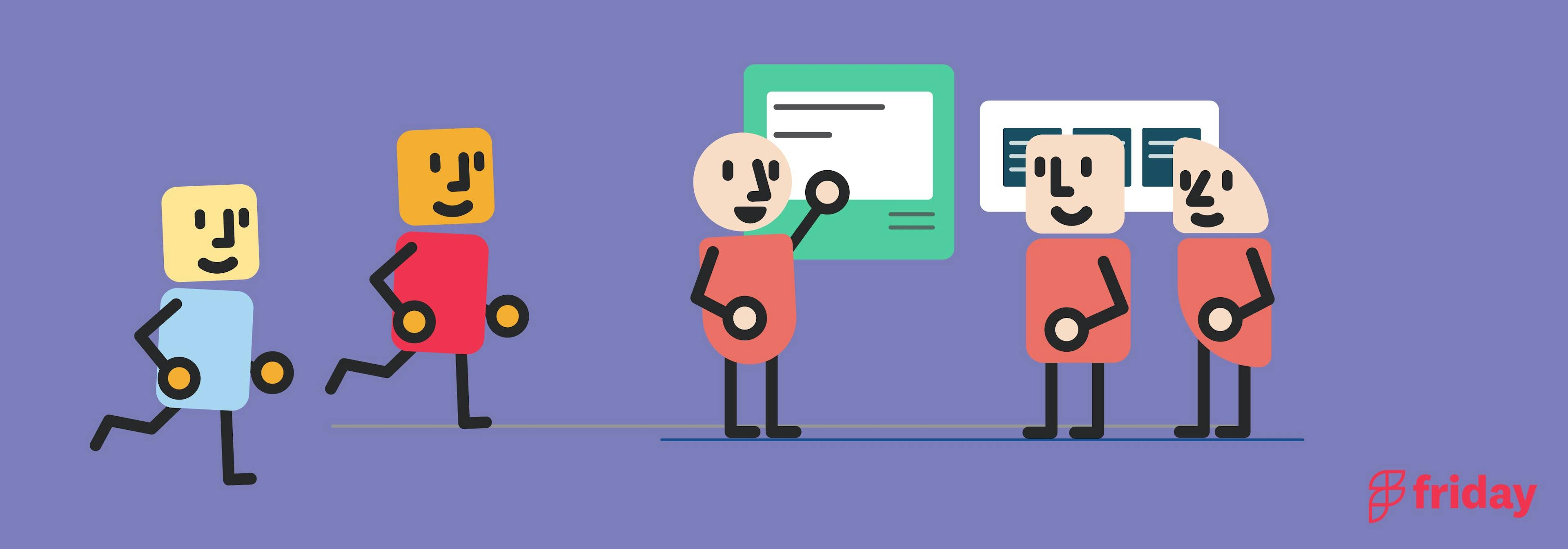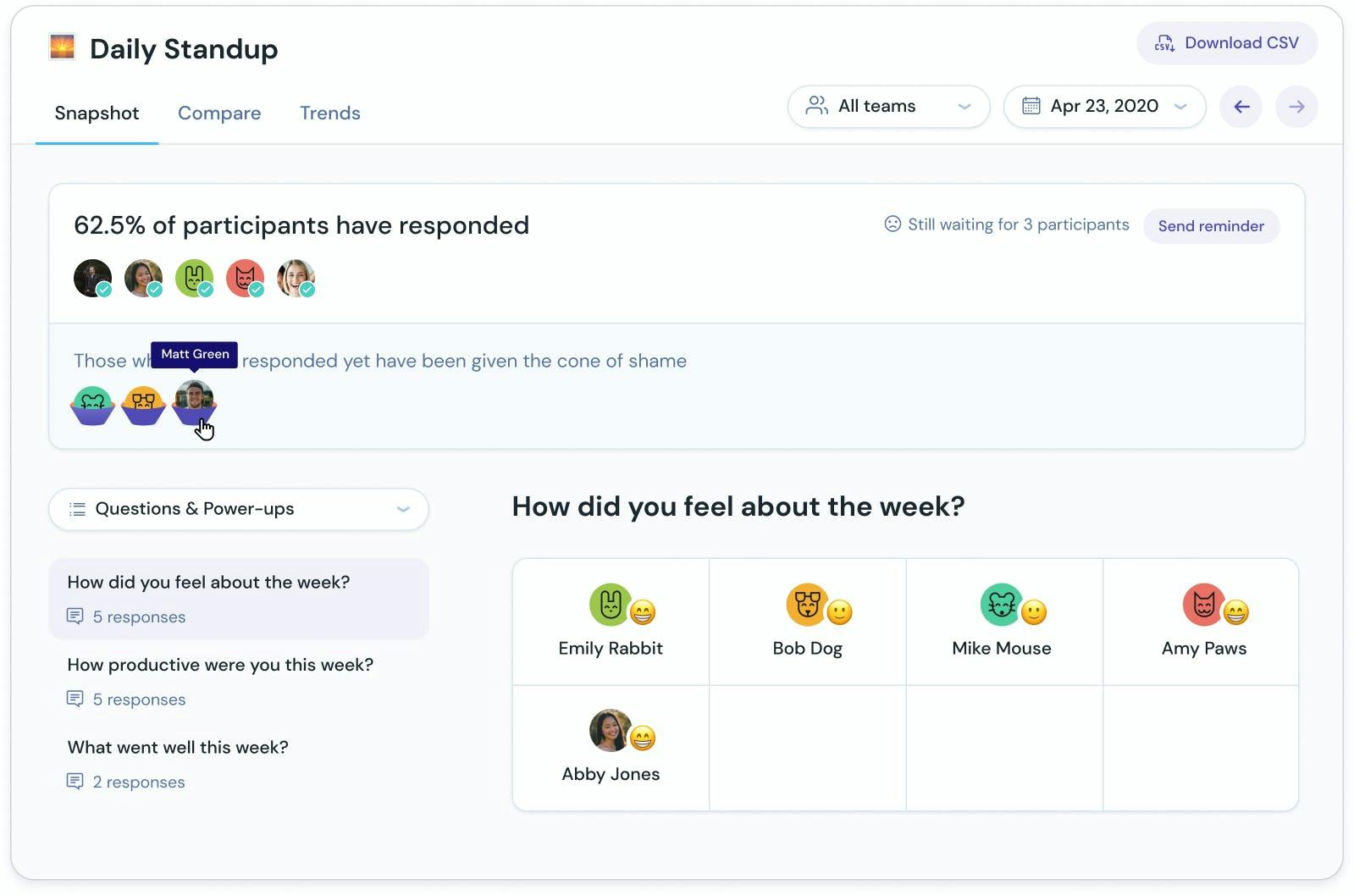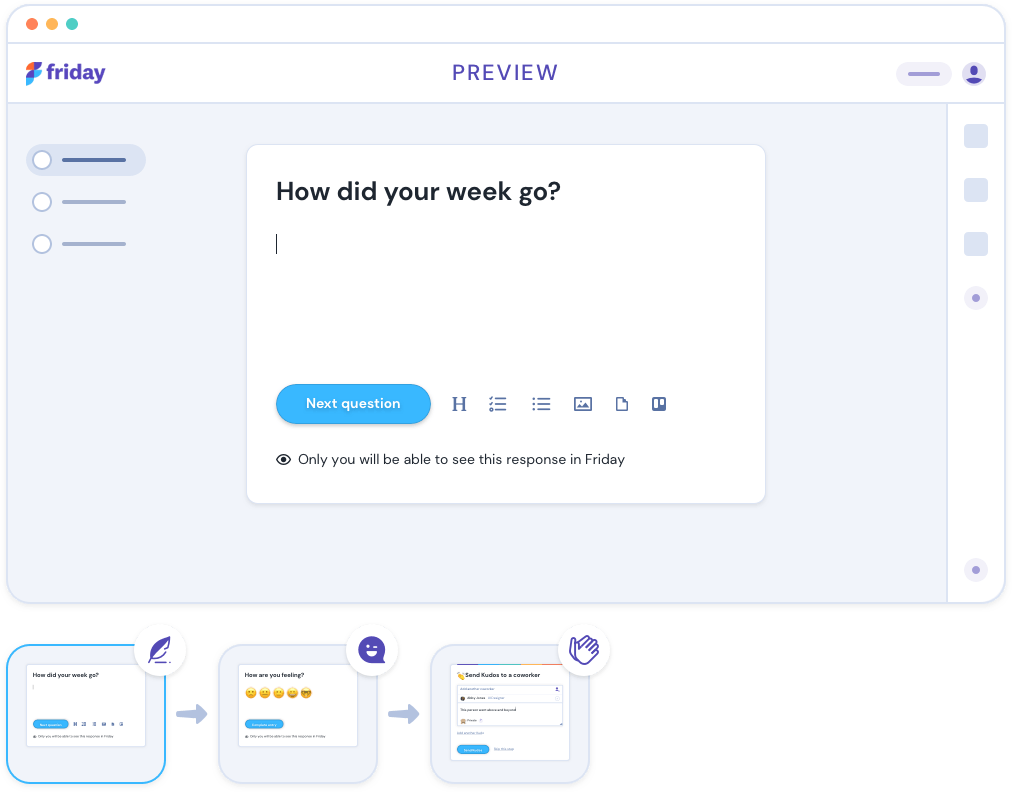How To Have Daily Huddles In Less Time

Daily huddles are all about setting a daily rhythm for your team. It’s a quick meeting, ideally at the beginning of the day, where all teams reflect on what yesterday was about and what’s planned for today and tomorrow. Daily huddles force teams to communicate effectively--highlight wins, challenges, and anything else that's important without taking up too much time for the rest of the team.
“Huddles were a foreign idea to us initially, but now they are an integral part of the workday,” says Randall C. Rickard, MD, of Family Practice Partners in Murfreesboro, Tenn.
With daily huddles and standups, most of them are done in person, over Zoom or a conference call. But with Friday, you can cut your daily huddle time in half.
Learn more about Daily Huddles in Friday.
There are various ways to conduct daily huddles and potential benefits and challenges that you should keep in mind when exploring this practice for your team.
What Is a Daily Huddle?
A team daily huddle is a 15-20 minute meeting, held each morning, where the team gathers to discuss the events of the previous day and plan for the day ahead.
The goal of the huddle is to reduce the communication gaps and keep everyone focused and working towards a shared organizational goal. A team huddles together daily, regardless of where they work or what time zone they’re in.
Importance of Daily Huddles
A team huddle is an important part of the culture of the team.
- It gives the team a chance to come together and see how they’re doing, both within the sprint, or the week.
- It ensures that the team is working well together and that they’re aware of how they’re doing against their goals.
- It’s a chance for them to celebrate progress, discuss problems, and plan for the coming day.
The fact that this meeting is visible and shared across the organization and is held daily encourages a culture where the team is responsible for their own success.
Here are the benefits of daily huddles:
1. Daily huddles save you time
When a communication rhythm is established, information moves through the organization accurately and quickly. This helps an organization work productively and address issues in a more timely manner.
2. Daily huddles reduce hassle
It often takes longer to set up meetings than it does to hold them. Pre-scheduling regular meetings act as placeholders in everyone's calendar thus reducing hassles.
Impact of the Daily Huddle on Collective Ownership
The team huddle is the team’s opportunity to come together and see how they’re doing, both within the sprint and for the year. It’s a chance for them to celebrate progress, discuss problems, and plan for the coming day. Huddles reconnect people to a company’s core mission. They reinforce employees’ commitment to serve customers better and create more promoters.
The fact that this meeting is visibly shared across the organization and is held daily encourages a culture where the team takes collective ownership of their own success.
The Daily Standup
The team huddle is run by the team lead or Scrum Master in agile, using a format that’s shared by the entire organization. Within the team, the daily huddle is a time for the product owner, Scrum Master, and team members. The team elects a facilitator to run the meeting, and everyone can take turns being the facilitator. Each person on the team is responsible for sharing information from their perspective.

If you are a team leader, running a daily standup should not be complicated. Here are some tips and best practices below:
- It should happen at the same time every day - you are trying to create a habit here. Holding these meetings at random times doesn't help create a habit.
- It should be quick and meaningful - aim for fifteen minutes or less. It should follow a set format and only focus on the important points.
- It should be inclusive - everyone should contribute, including you. You’re doing this as a team, after all.
- It should be scheduled keeping different time zones in mind - try to find a sweet spot.
Format of the Daily Huddle
The daily huddle should be structured around what’s called the three pillars of Scrum. The three pillars of Scrum are transparency, inspection, and adaptation.
1. Transparency
The team should share their velocity from the previous day, and any roadblocks or challenges that they ran into. Transparency is an important part of the team huddle because it makes the team’s progress visible to everyone. It helps the organization see progress and it allows the team to see how their work is contributing to the organization’s success.
2. Inspection
The team should share how far they are along in their work, and highlight any problems they’re facing. Inspections are formal, frequent, and focused on the work environment and product, not people. The inspection pillar helps everyone working on the team check on their work environment and product to see how well they’re doing. It helps the organization get a sense of how well everyone is doing and allows the team to spot problems early and fix them quickly.
3. Adaptation
The team should share any goals they have identified for the day and any other ideas that came up during the meeting. The Scrum Master’s role is to help the team make good decisions and then to help the teamwork through problems together. The team should focus on what they want to accomplish together, not on their individual goals.
What is the role of the product owner during the daily huddle?
The product owner should attend the daily huddle, but they should wait till the end of the huddle to share any information. This could include a list of potential stories that the team could work on or a list of feedback from other stakeholders.
Potential Challenges of the Daily Huddle
If team members are missing from the huddle, it’s a warning sign that the team might be fractured or that the members aren’t getting enough information about what’s happening.
If a team member is late or can’t attend the huddle for a day, the rest of the team shouldn’t wait for them. The meeting should start on time. If a team member can’t attend the huddle for a day or is late, they should listen to the recording after the meeting so that he or she can catch up with what happened during the meeting.
There’s also the option of asynchronous meetings. This is when two (or more) people can communicate without the requirement that they are “present” at the same exact moment in time. Async communication allows teams to share their updates and everyone else can go through them when they start their day.
Qualities of a Good Team Huddle
A good team huddle is driven by the team. The members should be choosing the topics, their order, and potential speakers. The Scrum Master should be facilitating the meeting and keeping the team focused on the three pillars of transparency, inspection, and adaptation. Each person on the team is responsible for sharing information from their perspective.
Daily Huddle Productivity Benefits
Here are some key benefits of doing daily huddles:
- They help keep ongoing projects on track between all the key stakeholders.
- They bring up potential challenges early on and help teams identify solutions to them.
- They force teams to report constraints even when they think it’s too small. That way you can identify a problem before it becomes too big.
Daily Huddle Mistakes
Here are some common daily huddle mistakes that affect productivity.
- They run too long which often makes people become unfocused and lose interest.
- They run all over the place instead of having a clear set focus and format.
- They aren’t taken seriously wherein team members don’t prepare for them in advance.
- They lack designated facilitators who establish orders and keep things moving.
- They involve too many people instead of just the key stakeholders such as team leads.
Effectiveness of Daily Huddles
Daily huddles enable real momentum to build and keep the flywheel of the business turning. With the daily huddle set in motion along with more detailed weekly, monthly and quarterly meetings, you’ll have created a meeting rhythm which essentially is the heartbeat of your organization. It’ll help your team better understand how to plan for each meeting and effectively communicate in each of them.
How To Do Daily Huddles & Standups in Friday
Want daily huddles but in half the time?
Conduct your daily huddle asynchronously, with simple updates using Friday.
Here’s how it works:
- Pick questions and prompts for your daily huddle
- Set a daily meeting cadence
- Reminders are sent via Slack, Teams, or email
- Share an update for the daily huddle
- Push updates automatically to Slack or Teams
- Get instant updates and reports

You can still have a meeting if you want, but most meetings (especially routine ones) begin with a status update before diving into collaboration. If you get your updates out of the way before you meet, you can instantly jump into more meaningful conversation.


